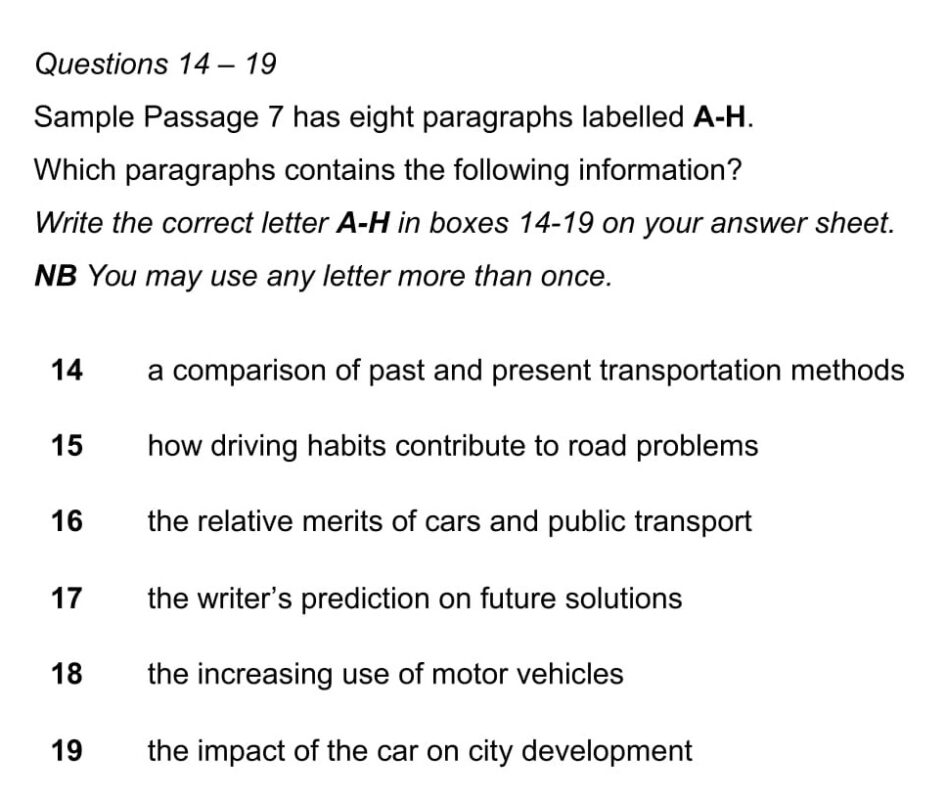
- Giới thiệu dạng bài
- Một số khó khăn thường gặp với Matching Information
- Hướng dẫn cách làm và phân tích ví dụ
Giới thiệu dạng bài
Dạng bài Matching Information là dạng nối thông tin lại với nhau. Đề bài sẽ yêu cầu thí sinh nối các statements (câu hỏi) với các đoạn văn có chứa thông tin phù hợp trong bài đọc phía trước. Các câu hỏi trong dạng bài này có thể nêu lên một số thông tin về: lý do, miêu tả, định nghĩa, đặc tính, sự tóm lược hay sự giải thích,… Các đoạn văn sẽ đánh chữ cái A,B,C để thí sinh có thể điền đáp án.
Dạng bài matching information to paragraph là dạng câu hỏi phổ biến trong IELTS, hay xuất hiện ở trong bài đọc số 2 và 3. Đề bài yêu cầu phải có khả năng tìm kiếm thông tin CỤ THỂ trong bài đọc nằm ở đâu.

Một số khó khăn thường gặp với Matching Information
Trong quá trình luyện đề IELTS Reading nói chung và luyện dạng bài Matching Information IELTS Reading nói riêng, thí sinh sẽ gặp phải vô số khó khăn. Vậy những khó khăn đó là gì và cách thức để vượt qua là như thế nào?
Vấn đề lớn nhất nằm ở việc người đọc phải hiểu ý nghĩa của từng đoạn trong bài. Thông tin để trả lời câu hỏi có thể nằm ở bất kì đâu. Vậy nên, cho dù bạn có hoàn thành bao nhiêu câu hỏi phía trước thì bạn vẫn mất thời gian để tìm câu trả lời cho toàn bộ bài đọc cho câu hỏi còn lại.
Thông tin để trả lời có thể không chỉ nằm trong 1-2 câu đơn lẻ trong đoạn văn mà có thể nằm trong cả đoạn văn đó. Do đó, nhiều khi bạn phải tìm được thông tin thật cụ thể và rất chi tiết trong đoạn, bên cạnh đó bạn phải hiểu ý nghĩa của toàn đoạn văn thì mới tìm được đáp án chính xác. Hơn nữa Không phải đoạn văn nào cũng có chứa đáp án, nhưng 1 đoạn văn có thể là đáp án của hơn 1 câu hỏi.
Hướng dẫn cách làm và phân tich ví dụ
The following passage has seven paragraphs, labelled A-G. Which paragraphs mention the following information? You do not need to mention all the paragraphs.
1 the relationship between local environment and behaviour
2 the benefits of asking around
3 becoming an organizer
4 partnerships against crime
5 problems which are not really problems
6 aspects of neighbourhood research
Will you love your neighbours?
A
When you are interested in buying a house, it’s easy to check the location and specifications of the house, but how can you assess an area’s community spirit – not just if the neighbours are friendly, but whether people will get involved in helping to deliver public services, setting up social enterprises and tackling local issues? Here are some tips for finding out what an area’s community spirit is like.
B
If an estate agent shows you around, ask for the vendor’s phone number. ‘Meeting the seller is an opportunity to find out what an area is like,’ says Chris Gittins, manager of Streets Alive (streetsalive.org.uk), works with residents, councils and voluntary groups to build communities by hosting events and activities in streets. It is also worth trying to meet the neighbours to find out more about an area. If you don’t find anyone at home, or don’t get a clear response, talk to people in the pub or the corner shop.
C
Living Streets (livingstreets.org.uk), which promotes safe, active and enjoyable streets, says steer clear of heavy traffic. Its research shows that people living on busy streets shield themselves from noise, don’t go outside and restrict their children’s independence – all of which reduces interaction with neighbours. And although an open space may seem like an asset, it can also become a source of conflict, says Dominic Church, senior adviser at the Commission for Architecture and the Built Environment. ‘If they are not kept clear and nobody is clearly responsible for the maintenance, they can become breeding grounds for graffiti, antisocial behaviour and kids mucking about,’ he says.
D
Local police can tell you whether there is a Neighbourhood (or Home) Watch scheme in your area (mynhw.co.uk). Living in an area with a scheme doesn’t just reduce your insurance premiums and ensure that the police tackle local issues such as theft: research shows that even when neighbours have nothing in common they share a desire to create a safe area and create a community spirit. If there isn’t a scheme, find out why.
E
Councils have lists of local voluntary organisations that can help to reveal the interests and activities of local communities. Some councils also run award schemes, which may include prizes for active and inspirational groups. Search the web, use social media and post queries on forums to find out residents’ views. This may give you more varied and up-to-date information than the council. Look at newschoolsnetwork.org to see if there are any plans to set up a new free school in the area. This is a sign of socially engaged parents and community motivation.
F
Floods, high crime levels and other issues can give a neighbourhood a bad image, but they can boost community spirit. In my case, the floods of 2007 brought people together to tackle climate change, which led to a low-carbon group that this year won two national competitions worth more than £800,000. The CrimeMapper website (maps.police.uk) provides information on crime and antisocial behaviour by area and police force. You can search by five types of crime and get details of your local neighbourhood policing team, its contacts, and the next ‘Have Your Say’ meeting.
G
If you are confident about the house, you could go ahead with the purchase and hold a street party to boost community spirit. ‘People who have just moved into a house are critical to setting up street parties,’ Gittins says. ‘After two or three years it becomes harder – they meet neighbours, get set in their routines, and feel less motivated.’
Bước 1: Đọc kỹ đề bài
- Bài viết về chủ đề neighbourhood
- Mỗi đoạn chỉ chứa tối đa 1 statement
Bước 2: Chọn keyword
1 the relationship between local environment and behaviour => keyword: bahaviour
2 the benefits of asking around => keyword: asking around
3 becoming an organiser => keyword: organiser
4 partnerships against crime => keyword: crime
5 problems which are not really problems => keyword: not real problems
6 aspects of neighbourhood research => keyword: reserch
Bước 3: Đọc từng đoạn từ A đến G, mỗi đoạn kiểm tra xem có thấy các từ cùng nghĩa hoặc cùng trường từ vựng với keyword không. Nếu thấy xuất hiện keyword thì check lại toàn bộ statement xem có tìm thấy đủ ý trong đoạn không.
Đoạn A:
Research: check, assess, finding out
aspects: if the neighbours are friendly,. ..will get involved in helping to deliver public services, setting up social enterprises and tackling local issues
=> đủ ý của câu 6
Đoạn B
asking around: trying to meet the neighbours, talk to people in the pub or the corner shop
benefits: an opportunity to find out
=> đủ ý của câu 2
Đoạn C
behaviour: shield themselves from noise, don’t go outside and restrict their children’s independence – all of which reduces interaction with neighbours.
environment: people living on busy streets, open space
=> đủ ý của câu 1
Crime: become breeding grounds for graffiti, antisocial behaviour and kids mucking
=> thiếu thông tin partnerships against
=> không chọn C cho câu 4
Đoạn D
Partnerships: Neighbourhood (or Home) Watch scheme, they share a desire to create a safe area and create a community spirit
against crime: ensure that the police tackle local issues such as theft
=> đủ ý của câu 4
Đoạn E
Không chứa keyword đã chọn
Đoạn F
problems: Floods, high crime levels and other issues
not really problems: bad image but can boost community spirit
=> đủ ý của câu 5
Đoạn G:
organisation: hold a street party to boost community spirit
=> đủ ý câu 3
Kết luận đáp án
1 C
2 B
3 G
4 D
5 F
6 A



